目录
4. int compareToIgnoreCase(String str)
1.常用方法
1.1字符串的构造
下面三种方式
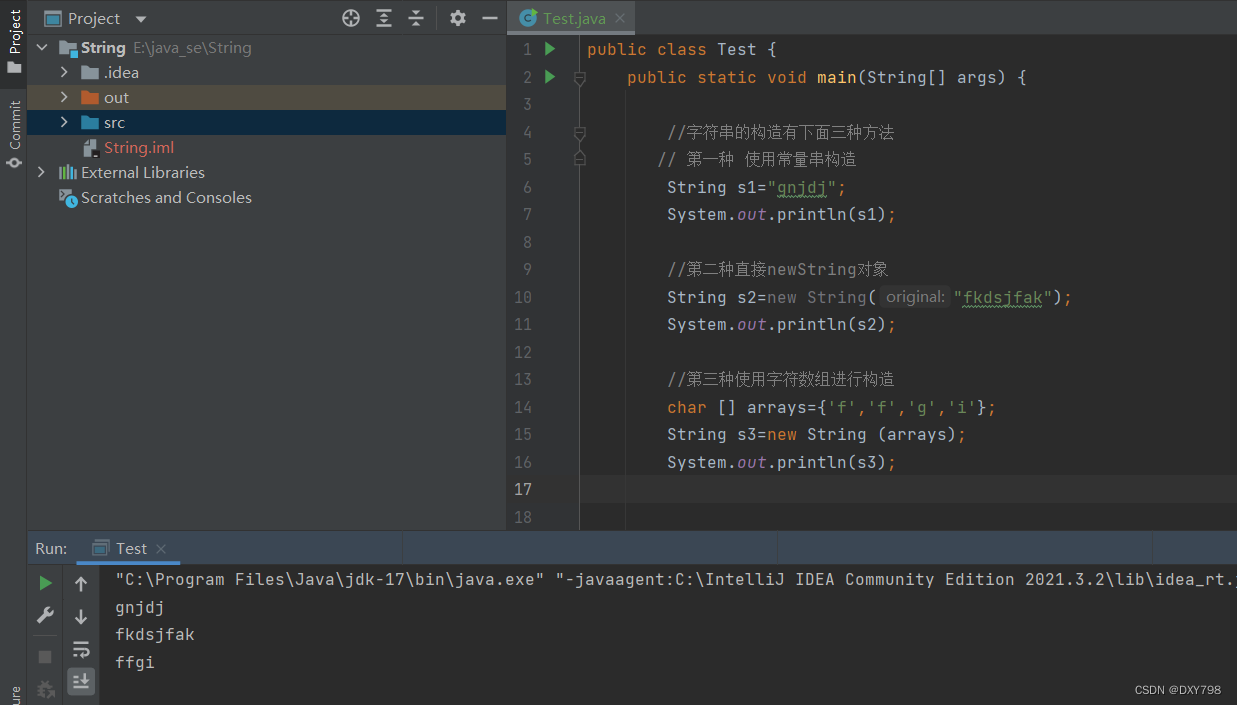
public class Test {
public static void main(String[] args) {
//字符串的构造有下面三种方法
// 第一种 使用常量串构造
String s1="gnjdj";
System.out.println(s1);
//第二种直接newString对象
String s2=new String("fkdsjfak");
System.out.println(s2);
//第三种使用字符数组进行构造
char [] arrays={'f','f','g','i'};
String s3=new String (arrays);
System.out.println(s3);
}
}
注意:
1.String是引用类型,内部并不存字符串本身(存的是地址)在String类的实现源码中,String类实例变量如下

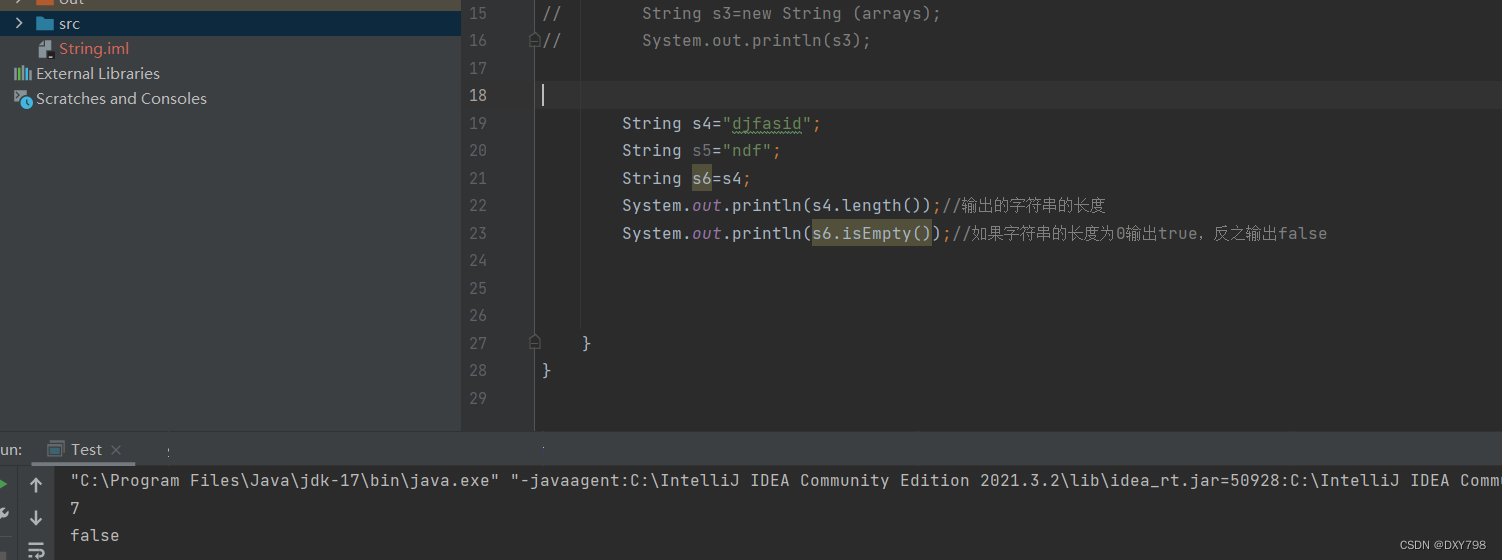
2. 在Java中“”引起来的也是String类型对象。

1.2字符串的比较
一共有四种方式
1.==
注意:对于内置类型,==比较的是变量中的值;对于引用类型==比较的是引用中的地址。
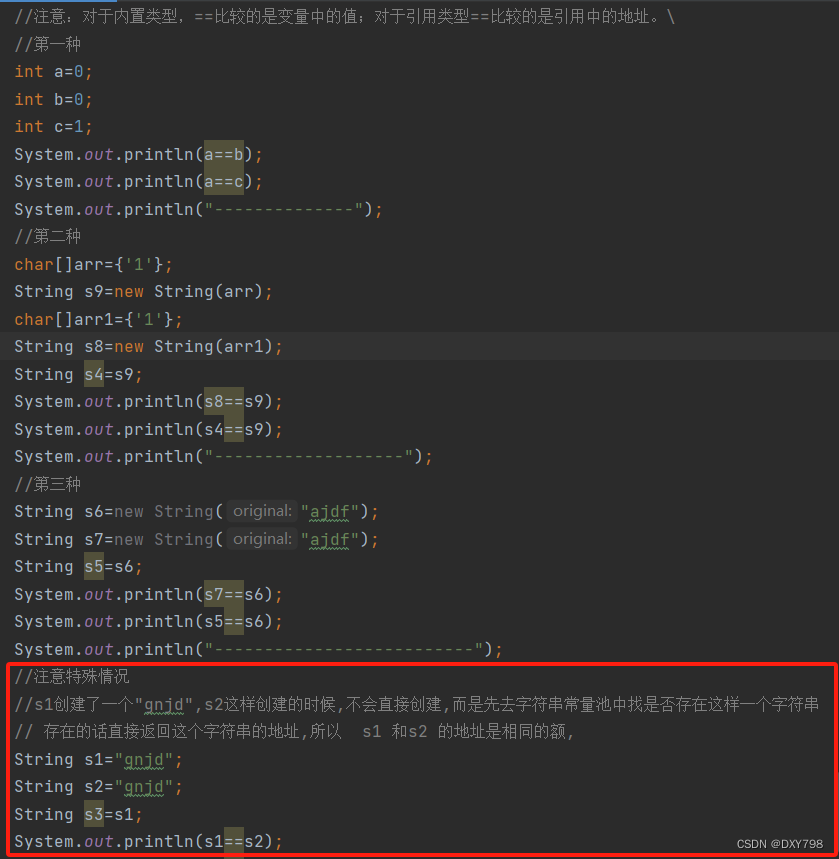
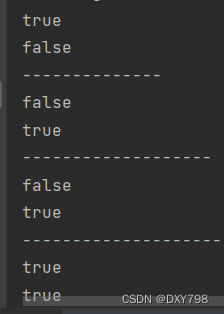
注意最下面的那种情况
2.equals
字典序:字符大小的顺序
String类重写了父类Object中equals方法,Object中equals默认按照==比较,String重写equals方法后,按照 如下规则进行比较,比如: s1.equals(s2)
public boolean equals(Object anObject) {
// 1. 先检测this 和 anObject 是否为同一个对象比较,如果是返回true
if (this == anObject) {
return true;
}
// 2. 检测anObject是否为String类型的对象,如果是继续比较,否则返回false
if (anObject instanceof String) {
// 将anObject向下转型为String类型对象
String anotherString = (String)anObject;
int n = value.length;
// 3. this和anObject两个字符串的长度是否相同,是继续比较,否则返回false
if (n == anotherString.value.length) {
char v1[] = value;
char v2[] = anotherString.value;
int i = 0;
// 4. 按照字典序,从前往后逐个字符进行比较
while (n-- != 0) {
if (v1[i] != v2[i])
return false;
i++;
}
return true;
}
}
return false;
}我们使用equals比较是不需要重写方法(直接用比较内容)
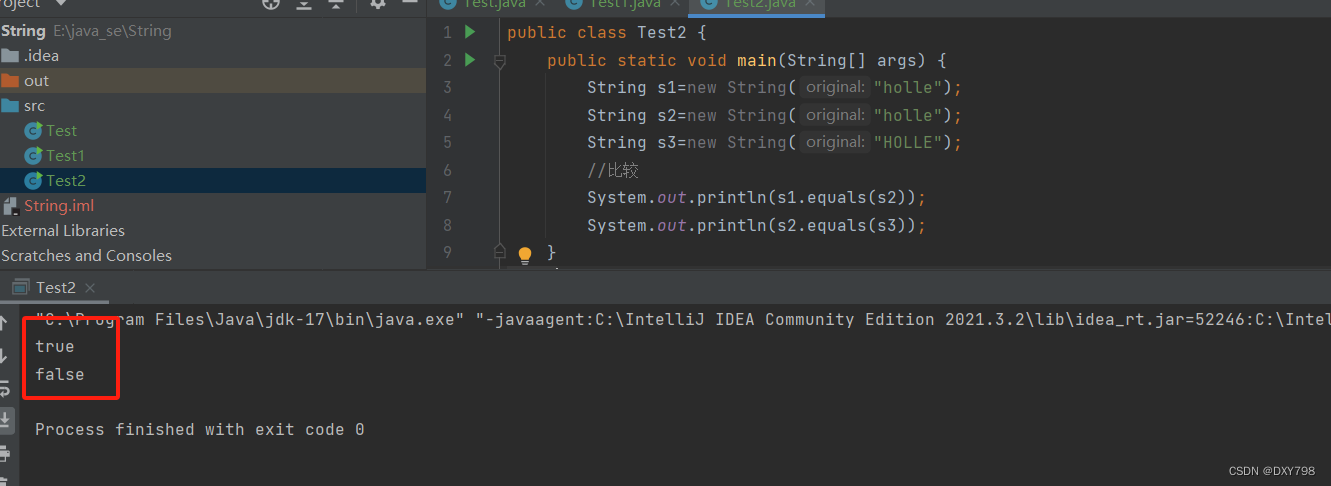
3. int compareTo(String s)
按照字典序进行比较
与equals不同的是,equals返回的是boolean类型,而compareTo返回的是int类型。具体比较方式:
1. 先按照字典次序大小比较,如果出现不等的字符,直接返回这两个字符的大小差值
2. 如果前k个字符相等(k为两个字符长度最小值),返回值两个字符串长度差值
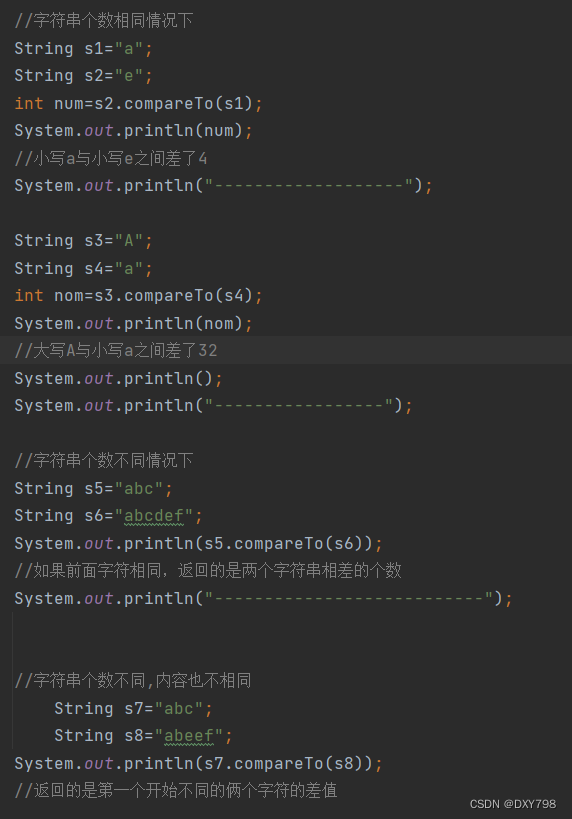
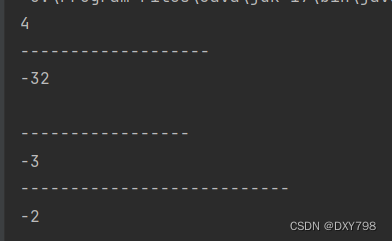
public class Test3 {
public static void main(String[] args) {
//字符串个数相同情况下
String s1="a";
String s2="e";
int num=s2.compareTo(s1);
System.out.println(num);
//小写a与小写e之间差了4
System.out.println("-------------------");
String s3="A";
String s4="a";
int nom=s3.compareTo(s4);
System.out.println(nom);
//大写A与小写a之间差了32
System.out.println();
System.out.println("-----------------");
//字符串个数不同情况下
String s5="abc";
String s6="abcdef";
System.out.println(s5.compareTo(s6));
//如果前面字符相同,返回的是两个字符串相差的个数
System.out.println("---------------------------");
//字符串个数不同,内容也不相同
String s7="abc";
String s8="abeef";
System.out.println(s7.compareTo(s8));
//返回的是第一个开始不同的俩个字符的差值
}
}
4. int compareToIgnoreCase(String str)
方法:与compareTo方式相同,但是忽略大小写比较
1.3字符串的查找
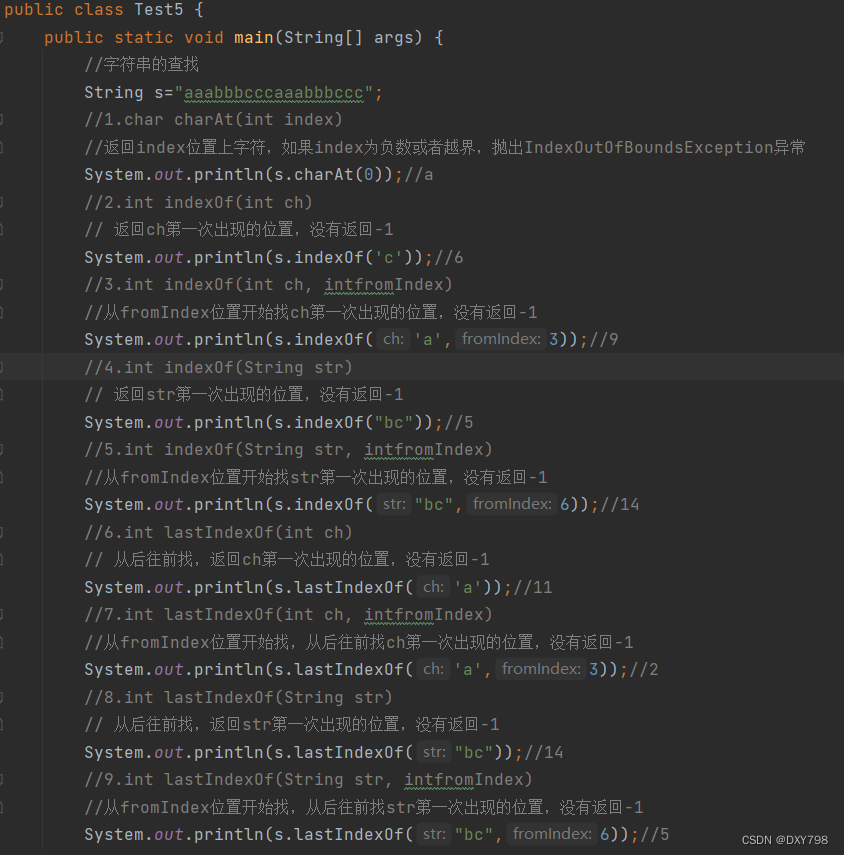
public class Test5 {
public static void main(String[] args) {
//字符串的查找
String s="aaabbbcccaaabbbccc";
//1.char charAt(int index)
//返回index位置上字符,如果index为负数或者越界,抛出IndexOutOfBoundsException异常
System.out.println(s.charAt(0));//a
//2.int indexOf(int ch)
// 返回ch第一次出现的位置,没有返回-1
System.out.println(s.indexOf('c'));//6
//3.int indexOf(int ch, intfromIndex)
//从fromIndex位置开始找ch第一次出现的位置,没有返回-1
System.out.println(s.indexOf('a',3));//9
//4.int indexOf(String str)
// 返回str第一次出现的位置,没有返回-1
System.out.println(s.indexOf("bc"));//5
//5.int indexOf(String str, intfromIndex)
//从fromIndex位置开始找str第一次出现的位置,没有返回-1
System.out.println(s.indexOf("bc",6));//14
//6.int lastIndexOf(int ch)
// 从后往前找,返回ch第一次出现的位置,没有返回-1
System.out.println(s.lastIndexOf('a'));//11
//7.int lastIndexOf(int ch, intfromIndex)
//从fromIndex位置开始找,从后往前找ch第一次出现的位置,没有返回-1
System.out.println(s.lastIndexOf('a',3));//2
//8.int lastIndexOf(String str)
// 从后往前找,返回str第一次出现的位置,没有返回-1
System.out.println(s.lastIndexOf("bc"));//14
//9.int lastIndexOf(String str, intfromIndex)
//从fromIndex位置开始找,从后往前找str第一次出现的位置,没有返回-1
System.out.println(s.lastIndexOf("bc",6));//5
}
}
1.4转换
1.4.1数值与字符串之间的转换
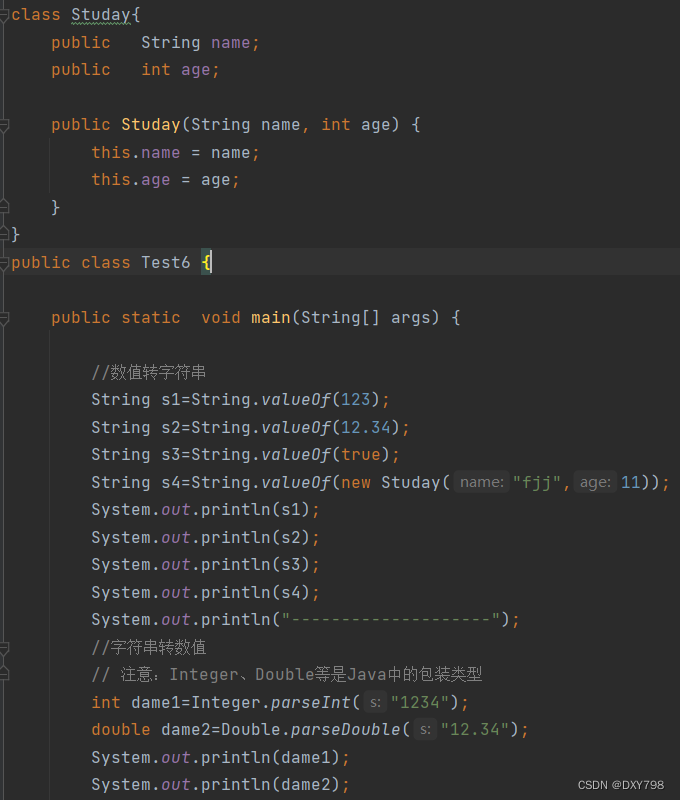
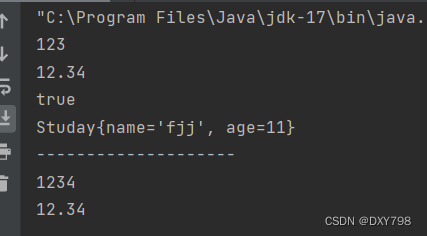
class Studay{
public String name;
public int age;
public Studay(String name, int age) {
this.name = name;
this.age = age;
}
@Override
public String toString() {
return "Studay{" +
"name='" + name + '\'' +
", age=" + age +
'}';
}
}
public class Test6 {
public static void main(String[] args) {
//数值转字符串
String s1=String.valueOf(123);
String s2=String.valueOf(12.34);
String s3=String.valueOf(true);
String s4=String.valueOf(new Studay("fjj",11));
System.out.println(s1);
System.out.println(s2);
System.out.println(s3);
System.out.println(s4);
System.out.println("--------------------");
//字符串转数值
// 注意:Integer、Double等是Java中的包装类型
int dame1=Integer.parseInt("1234");
double dame2=Double.parseDouble("12.34");
System.out.println(dame1);
System.out.println(dame2);
}
}
1.4.2大小写转换

public static void main(String[] args) {
String s1 = "hello";
String s2 = "HELLO";
// 小写转大写
System.out.println(s1.toUpperCase());
// 大写转小写
System.out.println(s2.toLowerCase());
}1.4.3字符串转数组
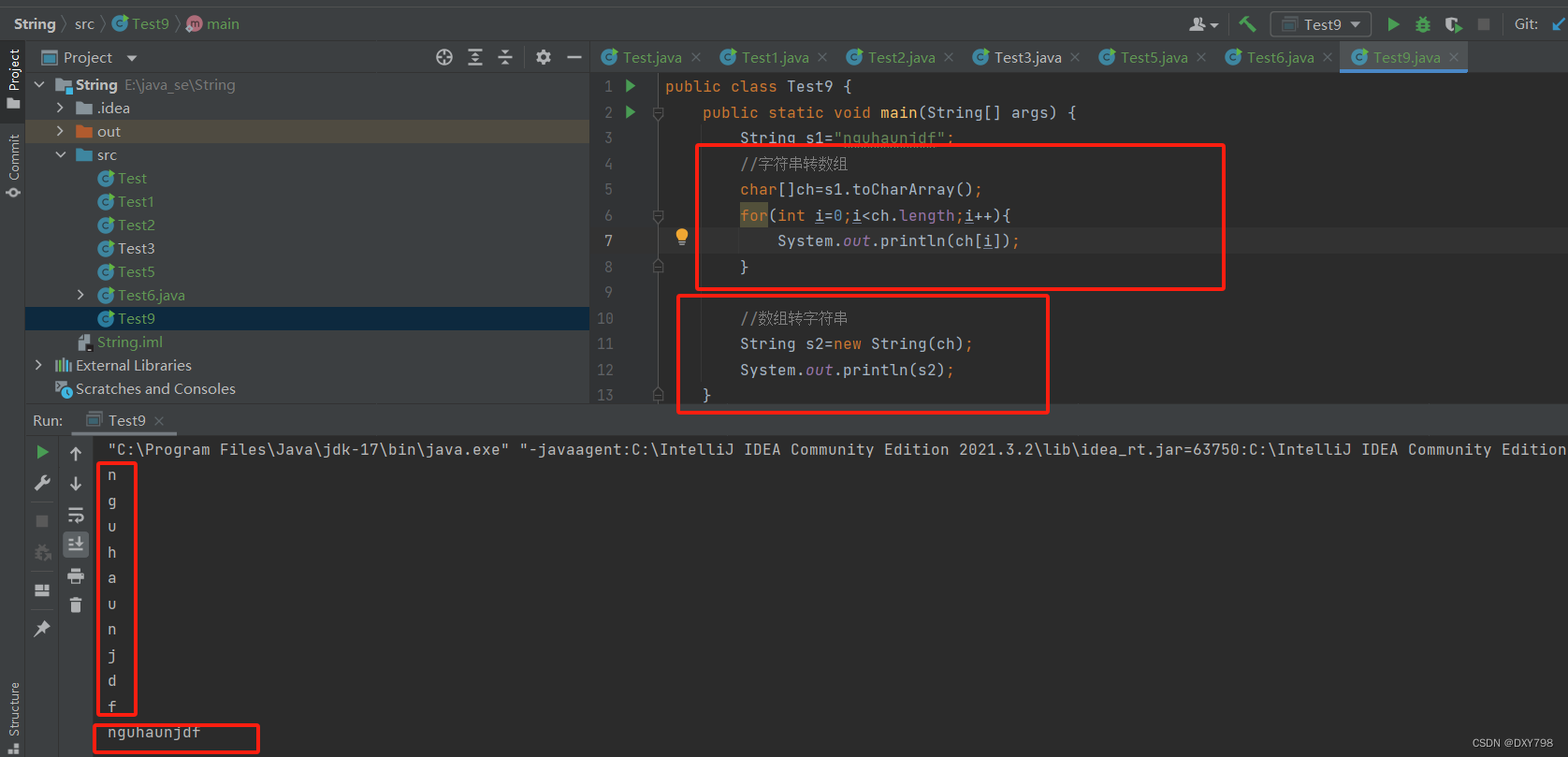
public class Test9 {
public static void main(String[] args) {
String s1="nguhaunjdf";
//字符串转数组
char[]ch=s1.toCharArray();
for(int i=0;i<ch.length;i++){
System.out.println(ch[i]);
}
//数组转字符串
String s2=new String(ch);
System.out.println(s2);
}
}
1.4.4格式化

public static void main(String[] args) {
String s = String.format("%d-%d-%d", 2019, 9,14);
System.out.println(s);
}1.5字符串的替换
使用一个指定的新的字符串替换掉已有的字符串数据,可用的方法如下:


String str = "helloworld" ;
System.out.println(str.replaceAll("l", "_"));
System.out.println(str.replaceFirst("l", "_"));注意事项: 由于字符串是不可变对象, 替换不修改当前字符串, 而是产生一个新的字符串.
1.6字符串的拆分
可以将一个完整的字符串按照指定的分隔符划分为若干个子字符串
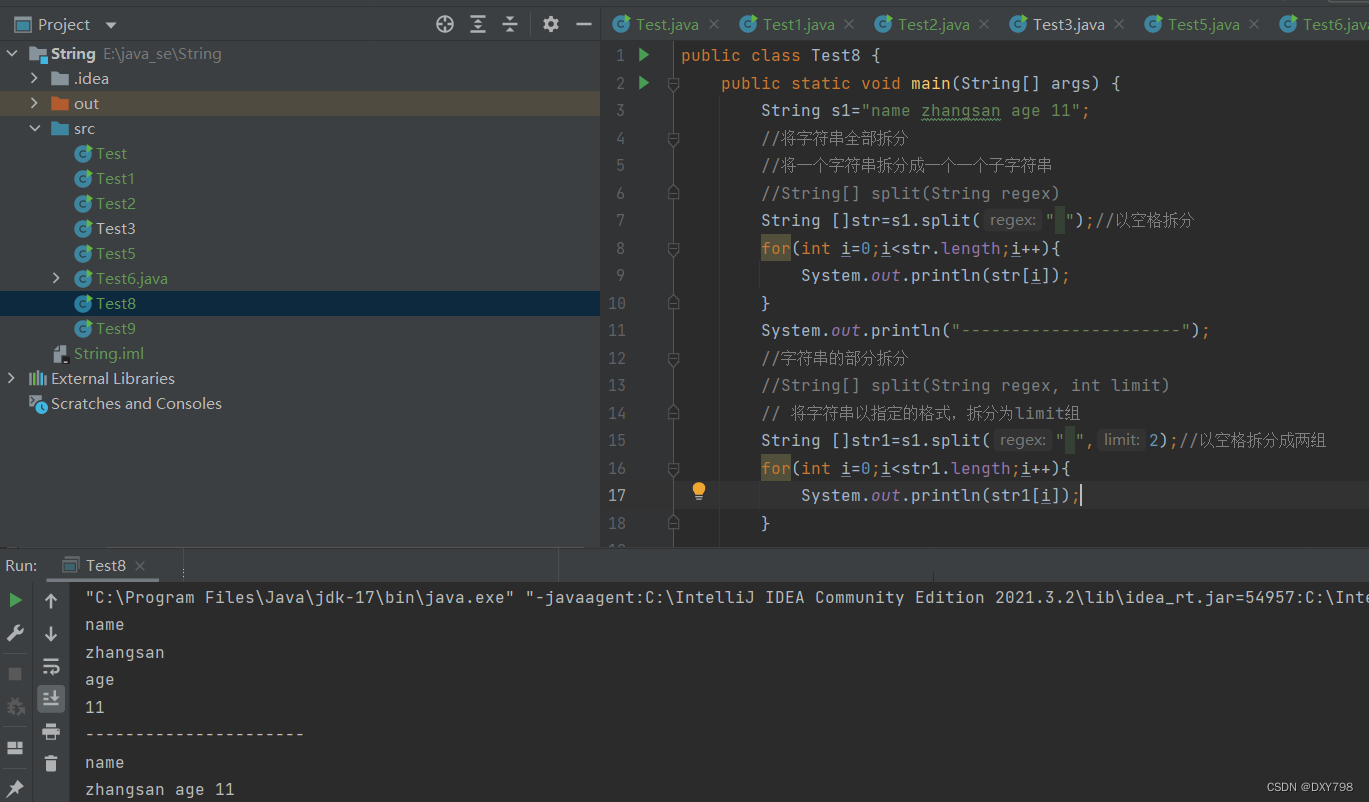
代码示例: 实现字符串的拆分处理
String str = "hello world hello bit" ;
String[] result = str.split(" ") ; // 按照空格拆分
for(String s: result) {
System.out.println(s);
}
代码示例: 字符串的部分拆分
String str = "hello world hello bit" ;
String[] result = str.split(" ",2) ;
for(String s: result) {
System.out.println(s);
}注意:有些特殊字符作为分隔符需要加上转义字符,才可以被识别
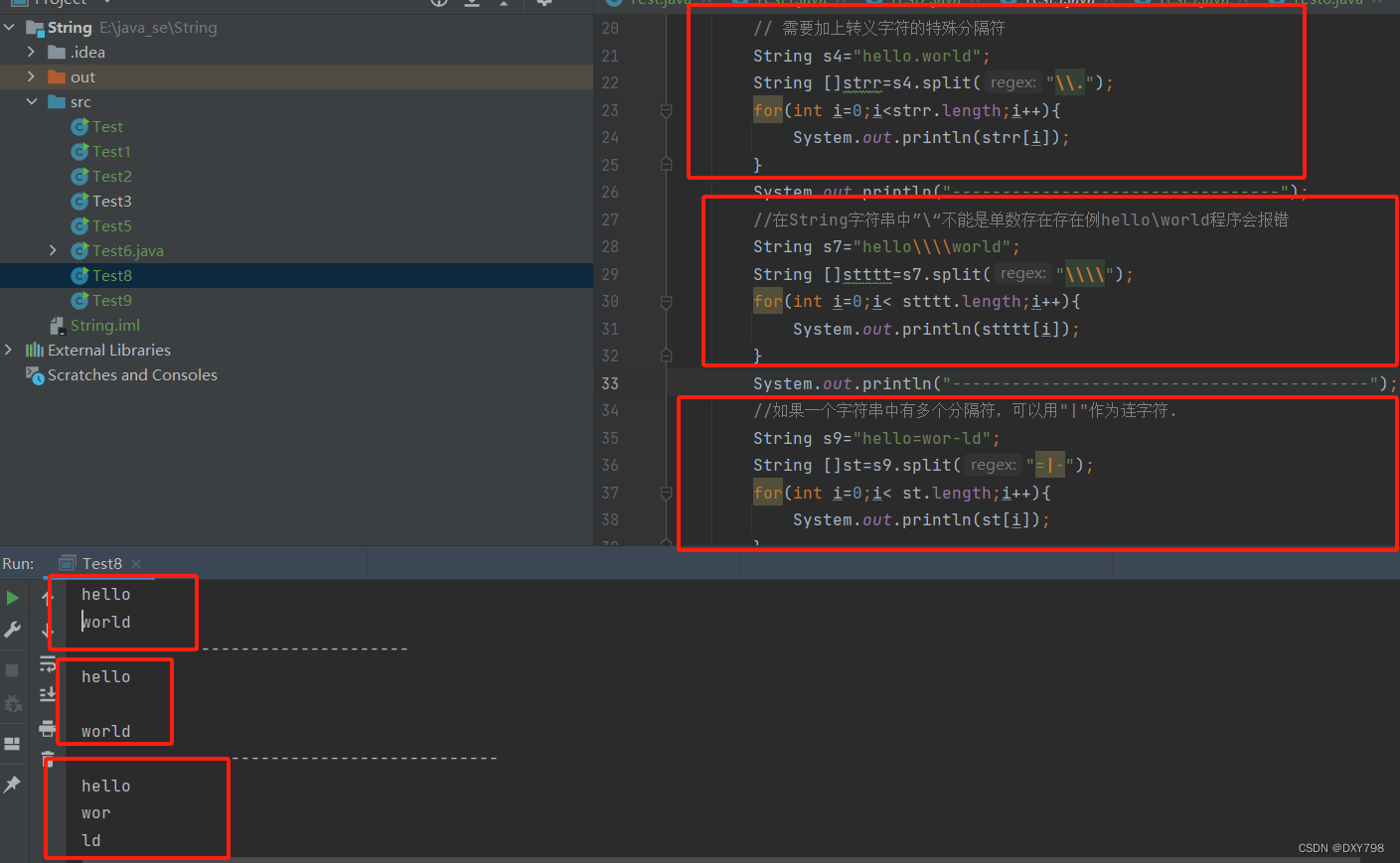
// 需要加上转义字符的特殊分隔符
String s4="hello.world";
String []strr=s4.split("\\.");
for(int i=0;i<strr.length;i++){
System.out.println(strr[i]);
}
System.out.println("---------------------------------");
//在String字符串中”\“不能是单数存在存在例hello\world程序会报错
String s7="hello\\\\world";
String []stttt=s7.split("\\\\");
for(int i=0;i< stttt.length;i++){
System.out.println(stttt[i]);
}
System.out.println("------------------------------------------");
//如果一个字符串中有多个分隔符,可以用"|"作为连字符.
String s9="hello=wor-ld";
String []st=s9.split("=|-");
for(int i=0;i< st.length;i++){
System.out.println(st[i]);
}
}注意事项:
1. 字符"|","*","+"都得加上转义字符,前面加上 "\\" .
2. 而如果是 "\" ,那么就得写成 "\\\\" .(在String字符串中”\“不能是单数存在存在例hello\world程序会报错)
3. 如果一个字符串中有多个分隔符,可以用"|"作为连字符.
//多次拆分 代码示例
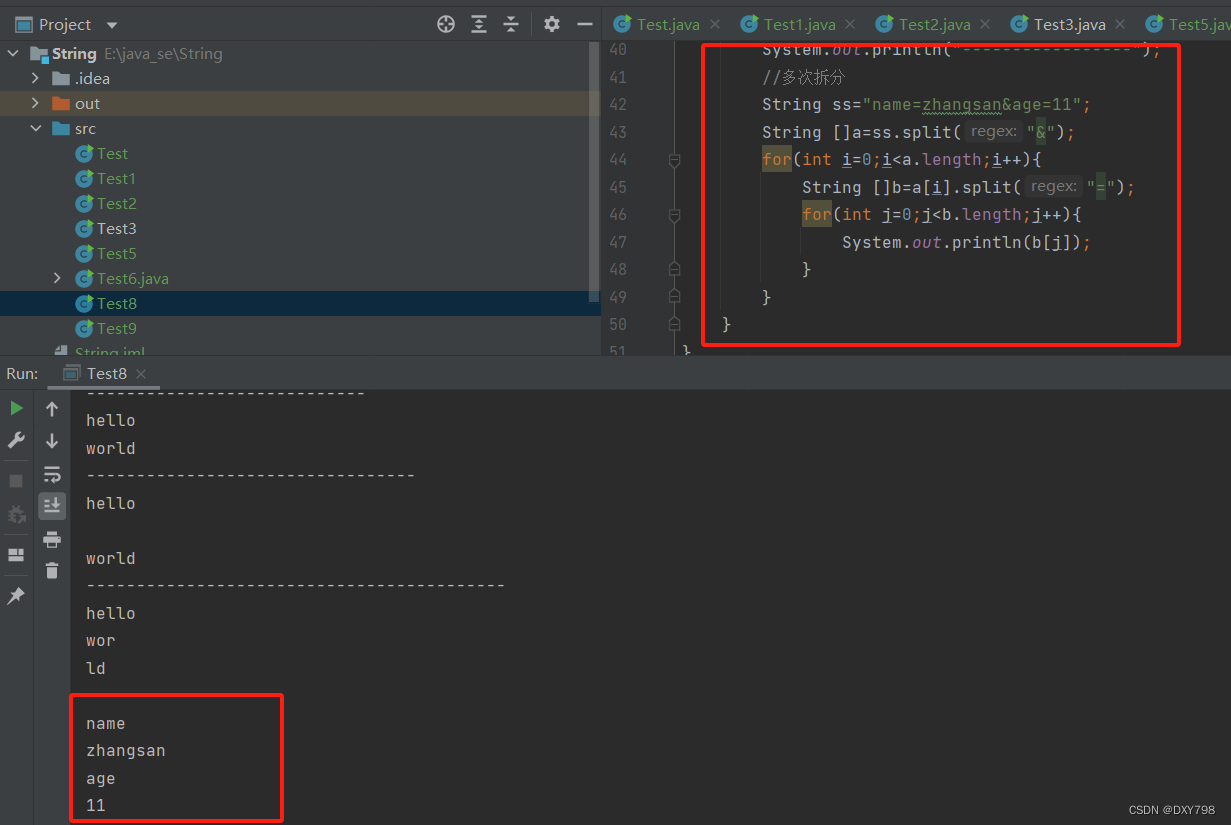
//多次拆分
String ss="name=zhangsan&age=11";
String []a=ss.split("&");
for(int i=0;i<a.length;i++){
String []b=a[i].split("=");
for(int j=0;j<b.length;j++){
System.out.println(b[j]);
}
}1.7字符串的截取
从一个完整的字符串之中截取出部分内容。(注意代码中一般都是默认为左闭右开)
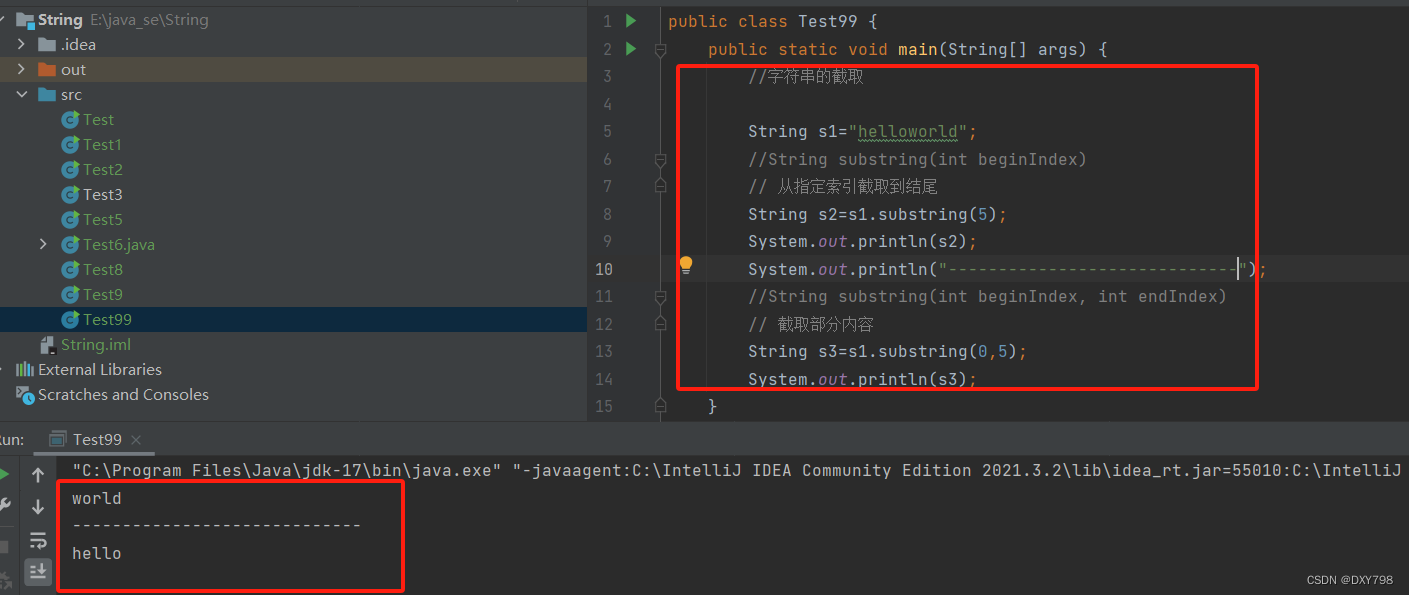
public class Test99 {
public static void main(String[] args) {
//字符串的截取
String s1="helloworld";
//String substring(int beginIndex)
// 从指定索引截取到结尾
String s2=s1.substring(5);
System.out.println(s2);
System.out.println("-----------------------------");
//String substring(int beginIndex, int endIndex)
// 截取部分内容
String s3=s1.substring(0,5);
System.out.println(s3);
}
}
注意事项:
1. 索引从0开始
2. 注意前闭后开区间的写法, substring(0, 5) 表示包含 0 号下标的字符, 不包含 5 号下标
1.8其它字符串操作
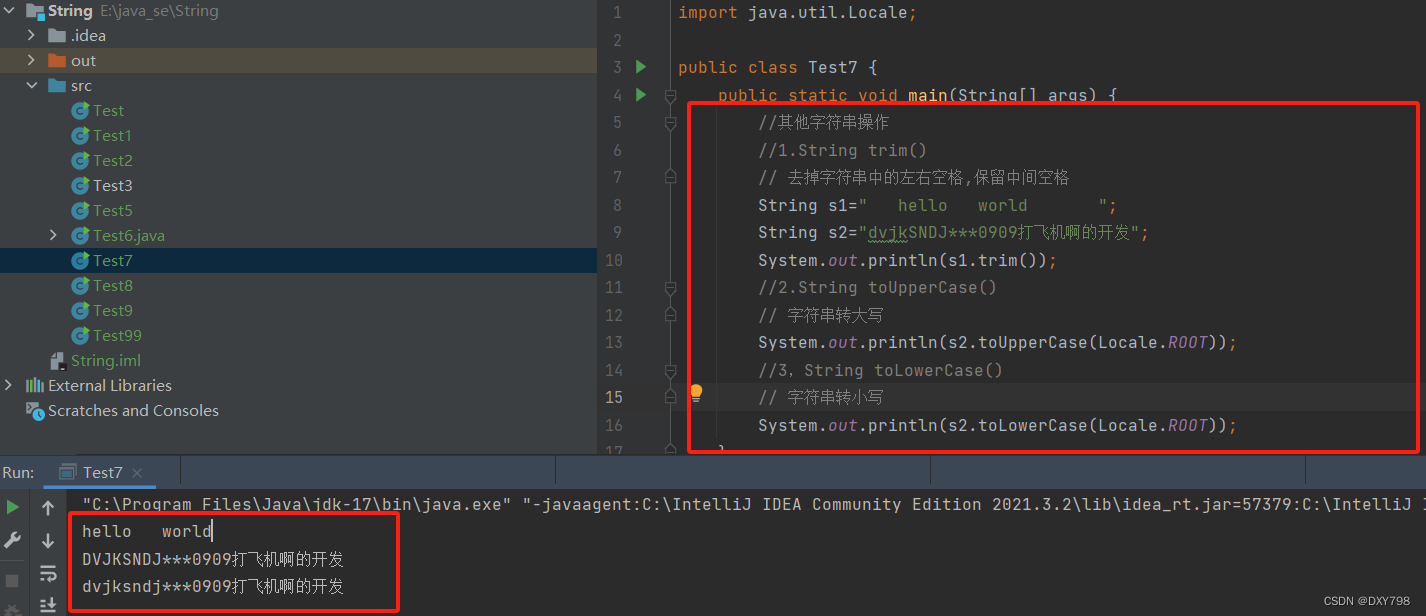
import java.util.Locale;
public class Test7 {
public static void main(String[] args) {
//其他字符串操作
//1.String trim()
// 去掉字符串中的左右空格,保留中间空格
String s1=" hello world ";
String s2="dvjkSNDJ***0909打飞机啊的开发";
System.out.println(s1.trim());
//2.String toUpperCase()
// 字符串转大写
System.out.println(s2.toUpperCase(Locale.ROOT));
//3,String toLowerCase()
// 字符串转小写
System.out.println(s2.toLowerCase(Locale.ROOT));
}
}





















 31万+
31万+

 被折叠的 条评论
为什么被折叠?
被折叠的 条评论
为什么被折叠?








